2 中国科学院地球科学研究院, 北京 100029;
3 中国科学院大学, 北京 100049;
4 国家地质实验测试中心, 北京 100037;
5 Institute of Geology and Mineralogy, Siberian Branch of Russian Academy of Science, Novosibirsk 630090, Russia;
6 中国科学院生物演化与环境卓越创新中心, 北京 100044)
阿尔泰山是中亚地区巨大山系之一,呈西北-东南走向,横亘于中国、蒙古、俄罗斯与哈萨克斯坦四国境内,绵延超过2000km。阿尔泰山位于亚欧大陆的结合部,研究区之北为北冰洋,是我国冬春“寒潮”和水汽的主要来源之一;西面是大西洋和中亚地中海、里海等湖泊,降水丰富。前人通常认为该区全新世气候变化可能受控于大西洋[1~5]和北极地区的巴伦支海和喀拉海的状况[6],也有学者认为冬季日照增强、CO2浓度增加、北极冰盖退缩以及地形对水汽的抬升作用也可能对该区气候变化起到一定的调节作用[7~9]。
阿尔泰山属于典型的干旱-半干旱地区,生态环境脆弱,对于气候和环境变敏感,在该区开展的气候研究同时具备理论和现实意义,因此受到国内外学者的广泛关注[10~18]。Huang等[10]对阿尔泰山区的喀纳斯湖孢粉记录及现代植被研究结果表明,8.5~4.0cal. ka B.P. 期间,乔木和灌木孢粉占比较高,研究区植被以森林为主,气候湿润,4.0 cal. ka B.P. 以后,木本植被孢粉占比持续下降,草本植被孢粉占比增加,植被由木本向草本演化,区域湿度降低、气候干旱;Rudaya等[12]根据孢粉数据重建了Hoton-Nur湖降水量,认为早-中全新世时期该区以针叶乔木为主,年降水量在330~550mm之间,气候湿润,中-晚全新世时期,该区以荒漠干旱植被占主要优势,年降水量下降至200~400mm,气候转为干旱;然而Zhang和Feng[13]对阿尔泰山及周边地区30个序列的花粉数据进行了集成研究,结果表明北疆地区全新世以来气候呈湿润趋势。在古温度重建方面,Rao等[15]根据阿尔泰泥炭α-cellulose δ13C、δ18O同位素研究,认为其可以作为冬季、夏季温度的代用指标,并依此重建了该区11.0cal. ka B.P. 以来的温度变化,发现阿尔泰地区全新世以来温度整体呈上升趋势;然而Huang等[10]利用喀纳斯湖孢粉数据及阿尔泰山区已发表的泥炭数据重建了全新世的气候历史和植被变化,认为该区在8.5~4.0cal. ka B.P. 期间气候温暖,4.0cal. ka B.P. 之后气候寒冷,温度呈现变冷趋势;Zhang等[18]利用Narenxia泥炭纤维素δ13C数据对阿尔泰地区进行的湿度重建认为8.0cal. ka B.P. 以来该区湿度增高,并将这种润湿趋势归因于温度降低和降水增多的综合影响。
从前人研究中可以看出我国西部地区全新世气候变化空间格局比较复杂,其原因可能主要为巨大的地貌差异。另外,指标的解译和定年也存在较大的不确定性。问题的解决有赖于获得更多的、多学科的高分辨率数据,加强现代过程和多指标的综合研究。
正构烷烃具有结构简单、含量丰富、来源多样、在生物体中对环境、气候变化敏感,在地质体中具有较强的抗侵蚀能力、不易发生降解的特点,因此被广泛应用于恢复过去气候变化、重建过去气候格局的研究中[19~24]。前人基于不同母质来源的正构烷烃分布差异,建立了正构烷烃平均链长(Average Chain Length, 简称ACL)、水生植物贡献比(Paq)、草木比(nC27/nC31)等分布特征指标用于探讨地质载体中正构烷烃所反映的母质来源及环境信息。通常认为ACL会随着有效湿度的增高而降低[24~25],植被类型变化也会对ACL产生影响[26~27];Paq可以反映出水生植被的贡献比例,当Paq高时水生植被占比较高,湖泊水位较高,气候湿润[28];nC27/nC31可作为反映汇水区植被变化的代用指标,nC27/nC31增高表示木本植被占比增高[22~24]。
本文对新疆双湖沉积物开展正构烷烃分布特征研究,讨论其环境指示意义,进而为研究区全新世以来的气候变化提供新的依据。
1 研究方法 1.1 研究区位置及特点双湖(48°52′N,87°02′E) 位于阿尔泰山中部,是山谷岩石滑塌阻塞形成的堰塞湖,由相隔300m左右的两个狭长小湖串连构成。湖长约1200m,宽度约300m,最大水深9m,面积约0.5km2(图 1)。
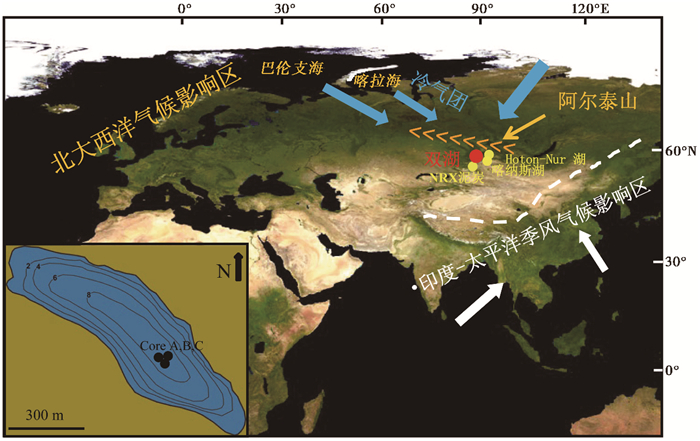
|
图 1 双湖及对比研究点所在位置 白色虚线表示印度-太平洋季风气候影响区;蓝色箭头表示来自高纬的冷气团,黄色三角形表示阿尔泰山;插图为双湖的测量等深线图和钻探取芯位置 Fig. 1 The location of Lake Shuang and comparative paleoclimatic records. White dashed lines show Indo-Pacific monsoon climate impact zone. The blue arrow indicates the cold air mass from high latitude. The yellow triangle represents the Altai Mountains. The inset map shows the bathymetry and coring sites of Lake Shuang |
研究区属于温带大陆性气候,冬季漫长寒冷,夏季短促温和[29],最冷月为2月,最热月为7月。该区降水量大,年均降水可达300mm,呈明显的双峰模式,即存在冬春季降雪峰值和夏季降水峰值,冬春季的降雪占全年降水的50 % 以上,湖水主要来自区域降水和冰雪融水。双湖地区年平均气温大致为-1℃,一年有一半的时间为冬季,最热月7月平均气温为15.9℃,最冷月平均气温为-16℃(图 2)。湖区相对湿度大,大致在60 % ~90 % 之间,森林内部湿度更大[29]。湖区植被覆盖良好,森林、草地广泛分布。
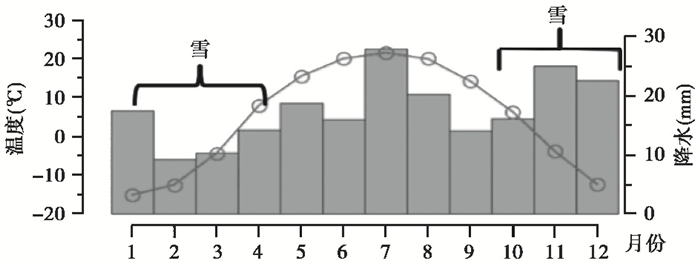
|
图 2 南阿尔泰山温度/降水变化特征 Fig. 2 Changes of temperature and precipitation in southern Altai Mountain |
我们使用无扰动重力钻在双湖中心钻取172cm岩芯。岩芯以1cm为间隔取样,样品经冷冻干燥后进行测年和地球化学分析。
核素(137Cs和210Pb)放射性测量在中国科学院地质与地球物理研究所新生代地质与环境重点实验室进行,设备为法国堪培拉欧洲系统测量公司(EURISYSMESURES)生产的EGPC100P15R低背景多道能谱分析系统。将2~3g样品装入直径为1.5cm试管中,密封20天以上,待Ra-Rn达到放射性准平衡状态后,将样品放入低背景多道能谱分析系统井型探头中进行γ射线能谱测量,测量时间约为12小时,210Pb和137Cs计数误差小于5 % 和3 %。
AMS14C在BETA放射性测年实验室(Beta Analytic Inc.)进行,测年样品的前处理按照ISO/IEC 17025:2005标准执行,并运用CALIB 4.03程序对所测的年龄进行日历年龄校正[30]。
1.3 正构烷烃提取与分析正构烷烃样品分析在国家地质实验测试中心完成。样品冷冻干燥后,利用ASE350进行有机物质提取。提取溶剂为二氯甲烷和甲醇(v ︰ v=9 ︰ 1),萃取温度为120℃,压力为1500 psi,加热6min,静态萃取10min,每次萃取循环两次。将抽提得到的有机提取物在氮气下浓缩,并用正戊烷定容。使用1000mg/6ml的SPE硅胶小柱对有机提取物进行柱色谱分离,并使用5ml正戊烷洗脱,进而得到饱和烃组分。使用岛津GC-2010气相色谱仪对饱和烃组分进行正构烷烃含量分析。气相色谱仪的初始温度为70℃,以3℃/min速率升至320℃并恒温20min。饱和烃含量是以已知浓度的nC7~nC40为外标,依据保留时间定性并根据峰面积相对比例计算得出。
2 结果 2.1 年代标尺的建立双湖上部137Cs、210Pbex、226Ra比活度与深度关系如图 3。岩芯3cm处137Cs比活度达到最大值(6.67dpm/g),该最大蓄积峰可能为1963/1964年全球137Cs沉降的高峰期。137Cs峰值非常明显,表明上部沉积物可能没有受到人类活动干扰。在7.0cm深度,137Cs比活度降为0左右。210Pbex比活度随深度呈指数下降,0~7cm采用Pb-CRS模式定年,7cm以下由于210Pbex比活度接近仪器误差(7cm处210Pbex比活度为0.81dpm/g,仪器误差为0.5dpm/g),不宜用于计算年龄,7cm以下的年龄根据AMS14C数据内插获得。所有的AMS14C年龄均使用CALIB 4.03[30]进行了校准,校准后的日历年龄见表 1。
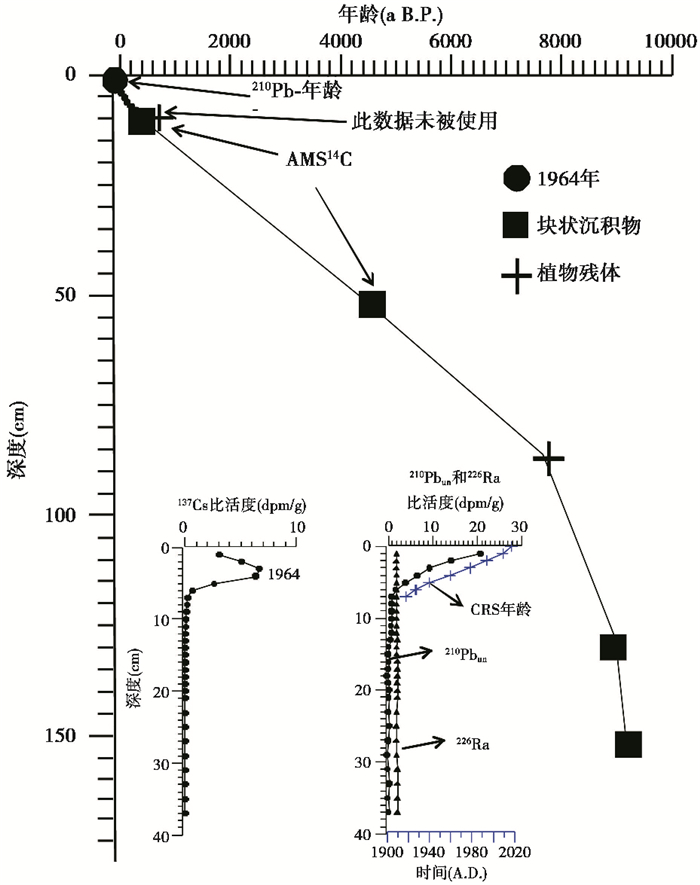
|
图 3 双湖湖泊沉积物岩芯年代序列 Fig. 3 Distribution of radiometric data of Lake Shuang based on 137Cs, 210Pb and AMS14C |
| 表 1 双湖的AMS14C放射性年龄数据 Table 1 AMS14C Radiocarbon ages from Lake Shuang |
11cm处植物残体测年数据为660±30a(575cal.aB.P.),而12cm处全岩有机质样品测年数据为1040±30a(950cal.aB.P.),这可能是受到“老碳”或“碳库”效应的影响。由于沉积物有机质样品可能来源于周边形成年龄较老的土壤,所以在进行全岩有机质测年时可能会导致测得的年龄偏老,我们将沉积物有机质测年年龄减去300年,根据校正后的AMS14C日历年龄进行内插获得岩芯的时间标尺。阿尔泰山双湖中心钻取的172cm岩芯反映了9.1cal. ka B.P. 以来的沉积历史。
2.2 正构烷烃分布特征双湖沉积物样品正构烷烃分析结果显示,大部分样品正构烷烃含量丰富,碳数主要分布在nC17~nC33之间,短链正构烷烃(nC17~nC21)含量低,中长链正构烷烃(nC23~nC33)含量较高且存在显著的奇偶优势(图 4)。过去9.1cal. ka B.P. 以来,正构烷烃组成变化比较明显,3.3cal. ka B.P. 之前,正构烷烃以nC27(平均含量为18.9μg/g)和nC31(平均含量为18.2μg/g)占优势(图 4a),3.3cal. ka B.P. 至今,正构烷烃以nC31(平均含量为16.2μg/g)占优势(图 4b)。

|
图 4 新疆双湖地区9.1cal. ka B.P. 以来正构烷烃分布特征 (a)9.1~3.3cal. ka B.P. 期间正构烷烃碳链模式;(b)3.3~0cal. ka B.P. 期间正构烷烃碳链模式条形图显示该阶段正构烷烃含量的平均值(浓度以μg/g干沉积物表示) Fig. 4 Distribution of n-alkanes in the sediment of Lake Shuanghu during 9.1cal. ka B.P. (a)Distribution of n-alkanes during 9.1~3.3cal. ka B.P.; (b)Distribution of n-alkanes since 3.3cal. ka B.P. The bar charts show mean values of n-alkanes (concentration expressed as μg/g dry sediment) |
过去9.1cal. ka B.P. 以来,中长链正构烷烃变化趋势基本一致(图 5):8.8cal. ka B.P. 之前正构烷烃含量较低,8.8~3.3cal. ka B.P. 期间含量增高,在3.3cal. ka B.P. 附近正构烷烃含量发生大幅度降低,3.3cal. ka B.P. 至今缓慢增加。其中,短链正构烷烃(nC19)变化幅度较小。总体来看,新疆双湖沉积物中长链正构烷烃(nC27~nC33)丰度较高,中链(nC23~nC25)和短链(nC17~nC21)正构烷烃含量较低。
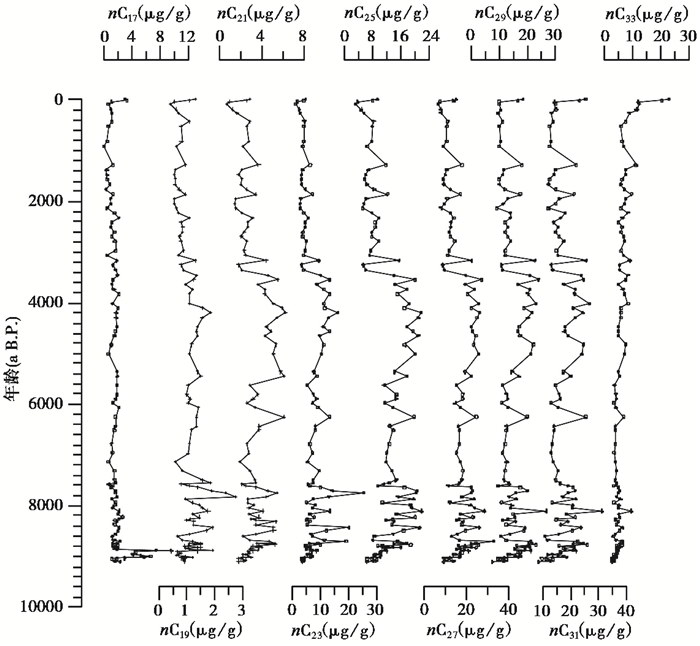
|
图 5 双湖沉积物中不同链长正构烷烃浓度 Fig. 5 Concentration of n-alkanes in the sediments of Lake Shuang |
图 6为新疆双湖地区正构烷烃各指标参数全新世以来的变化趋势。双湖沉积物的平均链长ACL23~33分布在26.97~29.95之间,均值为28.18;Paq分布在0.15~0.56之间,均值为0.36;nC27/nC31分布在0.45~1.42之间,均值为0.94。总体上看,9.1~8.8cal. ka B.P. 期间,ACL23~33在27.99~28.28之间,均值为28.15,处于较高水平,此阶段Paq(均值为0.33)和nC27/nC31(均值为0.98)均处在较低水平;8.8~3.3cal. ka B.P. 期间,Paq(均值为0.41)和nC27/nC31(均值为1.05)较上阶段有明显增高,ACL23~33在26.97~28.68之间,均值为27.85,较上阶段有所降低;3.3cal. ka B.P. 至今,Paq(均值为0.28)和nC27/nC31(均值为0.70)有明显降低,ACL23~33(均值为28.83)明显增高,且最近300年该变化趋势更为显著。

|
图 6 双湖沉积物正构烷烃指标参数变化曲线 Fig. 6 Proxies of n-alkanes in the sediments of Lake Shuang |
湖泊沉积物中的正构烷烃主要来源于陆生高等植物、沉水、浮水等水生植物以及藻类和菌类等低等生物[20~24]。研究表明,陆生高等植物的正构烷烃以nC27~nC35为主,沉水、浮水等水生植物的正构烷烃以nC21~nC25为主,而以nC17~nC21为主的短链正构烷烃主要来源于菌类、藻类等低等生物[31~32]。湖泊沉积物中的正构烷烃组成能够大致区分有机质的不同来源,但也存在一些不同的观点,比如前人在研究中发现桦树(Betula)叶蜡中含有nC23,一些藻类(如Botryococcus braunii)和泥炭藓(Sphagnum)也可以产生中链和长链正构烷烃,也有学者发现草本植物和木本植物都可以产生大量nC27、nC29和nC31,但从其不同链长的相对含量而言,高等植物以长链(>nC27)为主,水生植物以短链(<nC25)为主[33~35]。从双湖沉积物样品检测出的正构烷烃分布特征来看,沉积物样品为混合来源。以nC17和nC18为主峰的低碳数正构烷烃源自藻类等低等生物;中碳链正构烷烃来源于湖泊中的沉水/浮水植物;具有明显奇偶优势的高碳数正构烷烃则体现了典型的高等植物来源的特点,来自维管植物的叶蜡质。
根据正构烷烃组成与其来源的关联,前人定义了一系列指标,如长链正构烷烃平均链长(ACL)、用于表明大型水生植物来源的正构烷烃占水生和陆生植物来源的正构烷烃的比例的Paq(Aquatic Plant n-alkane Proxy)指数、草木比nC27/nC31等,用于探讨古气候、古环境变化[28, 36]。公式如下:

|
(1) |

|
(2) |
公式(1)和(2)中,RAi表示碳链长度为i的正构烷烃单体的相对丰度。
ACL是重要古气候、古环境变化指标之一,在古气候重建中得到了广泛应用[37~39]。ACL受到水热条件和植被类型等多方面因素的影响。Wang等[25]对位于中国400mm等降雨量线现代植被样品进行了正构烷烃和气候特征相关性的分析,发现ACL与夏季气温(6~8月)正相关。这是由于长链正构烷烃的熔点更高,且长链正构烷烃可以降低叶片渗透性,减少水分蒸发,进而保证植被在高温环境下的正常生理活动[40]。另外,有些学者认为温暖干旱条件下脂肪酸拉长酶的活性增强,也会提高长链正构烷烃的产量[25]。然而,Diefendorf和Freimuth[41]发现ACL和温度的相关性并不显著。由此可见,不同气候区、不同的地理环境中该指标的气候意义仍然存在一定争议。一些研究认为ACL可能和历史时期植被类型变迁有关,Howard等[26]对澳大利亚中部20个研究点的植被和土壤样品进行了正构烷烃研究,认为ACL值与草本和木本植被的相对丰度存在一定的相关性,可以作为大范围的植被变化指标;Rommerskirchen等[27]对非洲西南部海洋沉积样品的研究中将ACL值的增加归因为草本植被C4植物相对含量占比的增加。此外,植被类型和植物叶片形态都会对生成的正构烷烃链长产生影响[42~43]。
Paq指数是Ficken等[28]基于现代植被研究结果所定义,用于衡量大型水生植物来源的正构烷烃相对含量的一个参数。一般认为Paq较高指示大型水生植物比例较高,气候相对湿润;反之,Paq较低,表示陆生高等植物占比较高,气候相对干旱。对Paq的解释应基于湖泊形态和湖泊内植被分布,对于沉水/浮水植被较少的湖泊,Paq对于湖面变化可能不敏感[23]。
nC27/nC31可以用于评估草本植物和木本植物的相对贡献,反映历史时期的植被类型变迁,在湖泊沉积物研究中已有广泛应用[44~46]。新疆双湖地区的nC27/nC31在0.45~1.42之间,均值为0.94,整体呈下降趋势,指示汇水区植被经历了从木本植物向草本植物的演化过程。双湖沉积物nC27/nC31和Paq具有显著的正相关性(图 7a),长链正构烷烃平均链长ACL23~33和nC27/nC31均具有显著的负相关性(如图 7b),说明双湖沉积物正构烷烃参数ACL23~33、Paq和nC27/nC31可能受同种气候因素影响,指示类似的区域变化。Paq位于相对低值时,指示水生植物输入减少,湖泊水位低,气候环境相对干旱,nC27/nC31比值减小,表明汇水区有更多的草本植被输入[28, 44~46]。平均链长ACL23~33受到水热条件、植被类型等多方面因素的影响,当气候环境相对干旱时,植物为了维持正常的生态活动,会合成更多的长链正构烷烃进而提升叶片熔点,减少水分蒸发,同时干旱的气候条件也会造成陆生高等植被由木本向草本的转化,而植被类型的改变可以引起平均链长ACL23~33的增高[26~27](图 7b),由此可以推测ACL23~33的变化可能受到植被类型和区域气候的综合影响,而ACL23~33和nC27/nC31的强相关性可能表明植被变化是该区ACL23~33变化的主导因素。
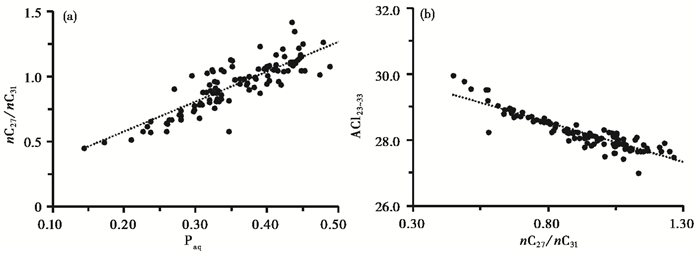
|
图 7 双湖正构烷烃nC27/nC31与Paq (a),ACL23~33与nC27/nC31 (b)的相关性 Fig. 7 Correction between parameters nC27/nC31 and Paq (a), ACL23~33 and nC27/nC31 (b)of Lake Shuang |
图 8为双湖正构烷烃ACL23~33、Paq和nC27/nC31与孢粉记录重建数据的对比。双湖沉积物正构烷烃参数指标指示的研究区植被变化大致可以分为3个阶段:1)9.1~8.8cal. ka B.P. 期间,Paq值较低,表明水生植被输入较少,nC27/nC31较低、ACL23~33较高指征汇水区有更多的草本植被输入。喀纳斯湖孢粉记录表明,早全新世时期木本和灌木植被相对含量较低[10];另外,哈纳斯自然保护区铁力沙汗泥炭剖面孢粉记录也表明早全新世时期(约8.0 cal. ka B.P. 前),荒漠植被藜科(Chenopodiaceae)、麻黄属(Ephedra distachya)和白刺属(Nitraria)含量较高,而湿生植被含量较低[47],巴里坤湖孢粉记录早8.0cal. ka B.P. 之前湖周植被以荒漠草本为主[48]。2)8.8~3.3cal. ka B.P. 期间,Paq和nC27/nC31均较上阶段有明显增加,ACL23~33位于较低水平,表明湖泊水位增高,大型水生植物的贡献增大,汇水区植被发生了由草本植物向木本植物的迁移,这与喀纳斯湖的孢粉记录相类似,喀纳斯湖孢粉记录表明8.5~4.0cal. ka B.P. 期间,以桦树和柳树为主的木本植物花粉含量处于高值,此阶段气候潮湿[10]。阿尔泰地区泥炭综合研究记录表明8.0~5.5cal. ka B.P. 期间植被由荒漠植被向湿生植被转变[47]。3)3.3cal. ka B.P. 以来,Paq和nC27/nC31发生显著下降,ACL23~33较上阶段有明显提升,表明该阶段水生植被贡献减少,草本植物相对占比增多。与双湖比邻的Hoton-Nur湖的孢粉记录表明5.0cal. ka B.P. 以来荒漠植被占比增加,硅藻减少[12]。喀纳斯湖孢粉记录表明4.0cal. ka B.P. 之后木本植物相对含量减少,草本植物相对含量增加,区域气候干旱[10]。阿尔泰地区Grusha湖和Akkol湖孢粉记录也反映中晚全新世时期,森林植被大量较少,针叶林逐渐消失,高山草原和灌丛植被增加,晚全新世气候变干[49]。
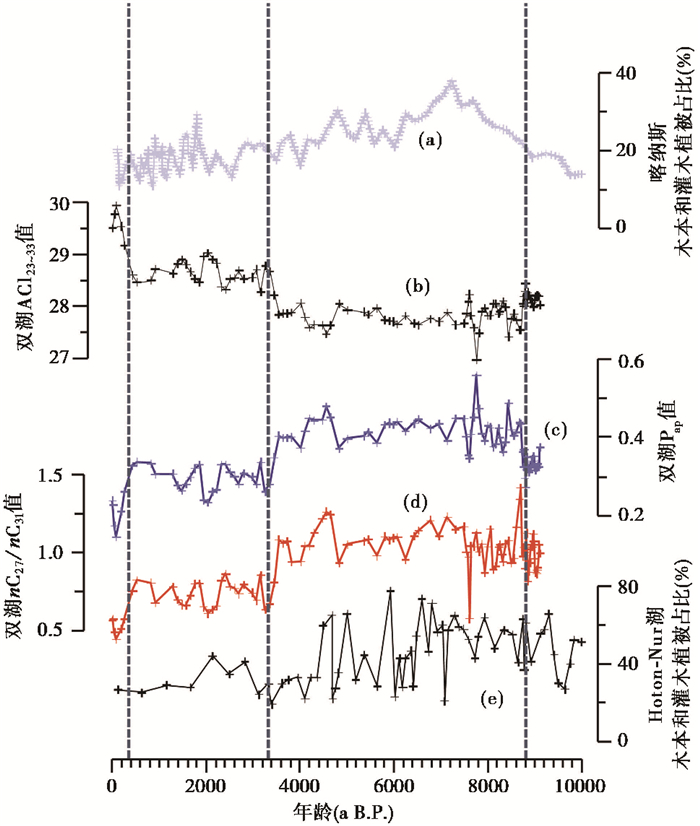
|
图 8 双湖正构烷烃指标与阿尔泰地区孢粉数据的对比 (a)喀纳斯湖木本和灌木孢粉占比[10];(b)双湖ACL23~33(本研究);(c)双湖Paq(本研究);(d)双湖nC27/nC31(本研究);(e)Hoton-Nur湖木本和灌木植被占比[12] Fig. 8 The index of n-alkanes from Lake Shuang in comparison with pollen data in the Altai Mountion. (a)Tree and shrub pollen content at Kanas Lake[10]; (b)ACL23~33 at Lake Shuang(this study); (c)Paq at Lake Shuang(this study); (d)nC27/nC31 at Lake Shuang(this study); (e)Tree and shrub pollen content at Hoton-Nur Lake[12] |
植被的演替变化很大程度受到区域环境有效湿度的影响。有效湿度是降水量和蒸发量的综合反映,可以指征该区域的水热条件,当降水越多、温度越低时,有效湿度越高,越有利于水生植被和汇水区木本植被相对含量的增加[50~51]。
双湖沉积物正构烷烃指标记录表明,早全新世时期(9.1~8.8cal. ka B.P.),水生植被输入较少,汇水区草本植被相对含量占比较高,气候干旱。前人对博斯腾湖和玛纳斯湖的研究也表明,早全新世时期两湖处于干涸状态[52~53]。阿尔泰山的Hoton-Nur湖孢粉和硅藻记录重建的区域年降水量指示,在早全新世时期该区降水量分布在200~300mm之间[12]。Rao等[15]对南阿尔泰地区泥碳同位素、现代水文观测以及现代同位素研究表明9.0~6.5cal. ka B.P. 期间,δ13C、δ18O处于相对高值,指示气候炎热;Narenxian泥炭br-GDGT分布分布特征指标MBT′ME重建结果表明,8.0cal. ka B.P. 之前,MBT′ME较高,指示该区早全新世时期气候温暖[54],由此可推测早全新世时期的干旱特征可能受到降水减少、温度增加的综合影响(图 9)。

|
图 9 双湖正构烷烃指标与阿尔泰地区湿度变化的对比 (a)Narenxian泥碳MBT′ME[54];(b)阿尔泰地区泥碳δ18O[15];(c)双湖ACL23~33(本研究);(d)Hoton-Nur湖年降水量(根据孢粉数据重建)[12];(e)双湖Paq(本研究) Fig. 9 Comparison of the index of n-alkanes from the sediment in Lake Shuang with the humidity variations in the records of the Altai Mountions. (a)MBT′ME from peat of Narenxian[54]; (b)δ18O from peat of Altai Mountains[15]; (c)ACL23~33 from Lake Shuang(this study); (d)Annual precipitation at Hoton-Nur Lake(based on pollen data)[12]; (e)Paq at Lake Shuang(this study) |
8.8~3.3cal. ka B.P. 期间,双湖沉积物正构烷烃指标记录表明该阶段水生植被的发育,指示湿度增加,气候处于相对适宜期。Hoton-Nur湖孢粉和硅藻记录重建的区域年降水量也表明早-中全新世时期,该区平均降水量在300~550mm之间,是全新世降水最多的时期[12]。温度重建结果也表明早-中全新世时期温度较低[54]。3.3cal. ka B.P. 至今,湖泊沉积物正构烷烃记录的双湖地区湿度下降,Hoton-Nur湖孢粉和硅藻记录重建的区域年降水量在5.0cal. ka B.P. 以来的中晚全新世时期,平均降水量减少到200~400mm之间[12],温度记录也表明晚全新世时期该区气温再次升高[54]。此阶段湿度降低可能受到温度和降水的协同作用。
综上所述,双湖研究区在早全新世时期(9.1~8.8cal. ka B.P. 前),水生植被较少,汇水区草本植被相对含量占比较高,8.8~3.3cal. ka B.P. 期间,该区水生植被大量发育,3.3cal. ka B.P. 至今水生植被输入减少,汇水区木本植被相对含量减少,草本占主要优势,植被的变化可能表明研究区早全新世(9.1~8.8cal. ka B.P. 前)和晚全新世(3.3cal. ka B.P. 至今)较为干旱,而8.8~3.3cal. ka B.P. 期间气候湿润,湿度的变化受到温度和降水的综合影响。
全新世温度变化一直存在争议,地质记录重建和古气候模拟的全新世温变化存在大致相反的趋势[55~57]。双湖沉积物ACL23~33指标自9.1cal. ka B.P. 以来呈逐渐增加的趋势,可能表明温度逐渐增加,这一结果与前人该区泥炭br-GDGT重建的温度序列[54],在全新世温度变化趋势上相似,也与古气候模拟的结果相似[56],但在百-千年尺度上,温度变化不一致,可能与指标的敏感性和定年精度有关。
4 结论(1) 通过对新疆阿尔泰山区双湖沉积物正构烷烃的研究,发现样品正构烷烃碳数分布在nC17~nC33之间,总体呈现以高碳数正构烷烃为主的分布特征,且显现出显著的奇偶优势,多数样品以nC27、nC31为主峰,沉积物有机质为混合来源,主要来自陆生高等植物、水生植物和浮游生物(藻类)。
(2) nC27/nC31与Paq、ACL23~33具有明显的相关性关系,表明指标可能受到同种气候驱动因素的影响,反映植被的演替变化。根据正构烷烃参数分布特征可初步划分为3个阶段:9.1~8.8cal. ka B.P. 水生植被输入较少,陆生植被中草本植物相对占比较高;8.8~3.3cal. ka B.P. 湖中大型水生植物大量繁殖,汇水区木本植物增多;3.3cal. ka B.P. 至今湖泊周围的木本植物减少,草本植物相对占比增多,水生植物输入减少。
(3) 植被演替变化受到有效湿度的影响,双湖沉积物正构烷烃ACL23~33指标自9.1ka B.P. 以来呈逐渐增加的趋势,可能表明温度逐渐增加,但也可能受降水或有效温度的影响。
致谢: 感谢编辑部老师及审稿人的悉心帮助和指导。
| [1] |
Chen F, Yu Z, Yang M, et al. Holocene moisture evolution in arid Central Asia and its out-of-phase relationship with Asian monsoon history[J]. Quaternary Science Reviews, 2008, 27(3-4): 351-364. DOI:10.1016/j.quascirev.2007.10.017 |
| [2] |
Chen F, Jia J, Chen J, et al. A persistent Holocene wetting trend in arid Central Asia, with wettest conditions in the Late Holocene, revealed by multi-proxy analyses of loess-paleosol sequences in Xinjiang, China[J]. Quaternary Science Reviews, 2016, 146: 134-146. DOI:10.1016/j.quascirev.2016.06.002 |
| [3] |
Long H, Shen J, Chen J, et al. Holocene moisture variations over the arid Central Asia revealed by a comprehensive sand-dune record from the central Tian Shan, NW China[J]. Quaternary Science Reviews, 2017, 174(15): 13-32. |
| [4] |
Ran M, Feng Z. Holocene moisture variations across China and driving mechanisms: A synthesis of climatic records[J]. Quaternary International, 2013, 313-314: 179-193. DOI:10.1016/j.quaint.2013.09.034 |
| [5] |
Wang W, Feng Z. Holocene moisture evolution across the Mongolian Plateau and its surrounding areas: A synthesis of climatic records[J]. Earth-Science Reviews, 2013, 122: 38-57. DOI:10.1016/j.earscirev.2013.03.005 |
| [6] |
陈隆勋, 朱乾根, 罗会邦, 等. 东亚季风[M]. 北京: 气象出版社, 1991: 306-307. Chen Longxun, Zhu Qiangen, Luo Huibang, et al. East Asian Monsoon[M]. Beijing: China Meteorological Press, 1991: 306-307. |
| [7] |
Prokopenko A, Khursevich G, Bezrukova E, et al. Paleoenvironmental proxy records from Lake Hovsgol, Mongolia, and a synthesis of Holocene climate change in the Lake Baikal watershed[J]. Quaternary Research, 2007, 68(1): 2-17. DOI:10.1016/j.yqres.2007.03.008 |
| [8] |
Zhang H, Zhang Y, Kong Z, et al. Late Holocene climate change and anthropogenic activities in north Xinjiang: Evidence from a peatland archive, the Caotanhu wetland[J]. The Holocene, 2015, 25(2): 323-332. DOI:10.1177/0959683614558646 |
| [9] |
Feng Z, Wu H, Zhang C, et al. Bioclimatic change of the past 2500 years within the Balkhash Basin, Eastern Kazakhstan, Central Asia[J]. Quaternary International, 2013, 311: 63-70. DOI:10.1016/j.quaint.2013.06.032 |
| [10] |
Huang X, Wei P, Natalia R, et al. Holocene vegetation and climate dynamics in the Altai Mountains and surrounding areas[J]. Geophysical Research Letters, 2018, 45(13): 6628-6636. DOI:10.1029/2018GL078028 |
| [11] |
饶志国, 郭海春. 北疆阿尔泰哈拉沙子高山泥炭岩芯孢粉记录是否指示全新世温度变化历史?[J]. 第四纪研究, 2021, 41(2): 612-620. Rao Zhiguo, Guo Haichun. Is the pollen-based taiga biome score record from alpine Sahara sand peatland in the southern Altai Mountains of northern Xinjiang an indicator of Holocene temperature history?[J]. Quaternary Sciences, 2021, 41(2): 612-620. |
| [12] |
Rudaya N, Tarasov P, Dorofeyuk N, et al. Holocene environments and climate in the Mongolian Altai reconstructed from the Hoton-Nur pollen and diatom records: A step towards better understanding climate dynamics in Central Asia[J]. Quaternary Science Reviews, 2009, 28(5-6): 540-554. DOI:10.1016/j.quascirev.2008.10.013 |
| [13] |
Zhang D, Feng Z. Holocene climate variations in the Altai Mountains and the surrounding areas: A synthesis of pollen records[J]. Earth-Science Reviews, 2018, 185: 847-869. DOI:10.1016/j.earscirev.2018.08.007 |
| [14] |
张彦, 马学彗, 刘兴土, 等. 新疆阿尔泰山区全新世泥炭丘形态、发育过程与泥炭堆积速率初探[J]. 第四纪研究, 2018, 38(5): 1221-1232. Zhang Yan, Ma Xuehui, Liu Xingtu, et al. Preliminary study on morpholopy, development process and peat accumulation rate of palsas during the Holocence in the Altai Mountains, northern Xinjiang Autonomous Region, Northwest China[J]. Quaternary Sciences, 2018, 38(5): 1221-1232. |
| [15] |
Rao Z, Shi F, Li Y, et al. Long-term winter/summer warming trends during the Holocene revealed by α-cellulose δ18O/δ13C records from an alpine peat core from Central Asia[J]. Quaternary Science Reviews, 2020, 232(15): 106217. DOI:10.1016/j.quascirev.2020.106217 |
| [16] |
Agatova A, Nazarov A, Nepop R, et al. Holocene glacier fluctuations and climate changes in the southeastern part of the Russian Altai (South Siberia) based on a radiocarbon chronology[J]. Quaternary Science Reviews, 2012, 43: 74-93. DOI:10.1016/j.quascirev.2012.04.012 |
| [17] |
Agatova A. Geomorphologic mapping of the Chagan-Uzun River basin: A key for reconstructing history of Pleistocene glaciations in the southern Altai[J]. Stratigraphy and Geological Correlation, 2005, 13(6): 656-666. |
| [18] |
Zhang D, Feng Z, Yang Y, et al. Peat δ13C celluose-recorded wetting trend during the past 8000 years in the southern Altai Mountains, northern Xinjiang, NW China[J]. Journal of Asian Earth Sciences, 2018, 156: 174-179. DOI:10.1016/j.jseaes.2018.01.029 |
| [19] |
郑邦, 周斌, 王可, 等. 晚全新世东海泥质区物源输入、源区植被变化及其影响因素: 来自MD06-3039A孔的正构烷烃记录[J]. 第四纪研究, 2018, 38(5): 1293-1303. Zheng Bang, Zhou Bin, Wang Ke, et al. Changes of provenance input and source vegetation changes and their impact factors since Late Holocene based on n-alkanes records from core MD06-3039A in the muddy area of the East China Sea[J]. Quaternary Sciences, 2018, 38(5): 1293-1303. |
| [20] |
Chu G, Sun Q, Xie M, et al. Holocene cyclic climatic variations and the role of the Pacific Ocean as recorded in varved sediments from Northeastern China[J]. Quaternary Science Reviews, 2014, 102: 85-95. DOI:10.1016/j.quascirev.2014.08.008 |
| [21] |
Wang G, Feng X, Han J, et al. Paleovegetation reconstruction using δ13C of soil organic matter[J]. Biogeosciences Discussions, 2008, 5(2): 1795-1823. |
| [22] |
马雪云, 魏志福, 王永莉, 等. 末次冰盛期以来东北地区霍拉盆地湖泊沉积物记录的C3/C4植被演化[J]. 第四纪研究, 2018, 38(5): 1193-1202. Ma Xueyun, Wei Zhifu, Wang Yongli, et al. C3/C4 vegetation evolution recorded by lake sediments in the Huola basin, Northeast China since the Last Glacial Maximum[J]. Quaternary Sciences, 2018, 38(5): 1193-1202. |
| [23] |
Xie M, Sun Q, Dong H, et al. n-Alkanes and compound carbon isotope records from Lake Yiheshariwusu in the Hulun Buir sandy land, Northeastern China[J]. The Holocene, 2020, 30(10): 1451-1461. DOI:10.1177/0959683620932968 |
| [24] |
何薇, 汪亘, 王永莉, 等. 四川邛海湖泊沉积物记录的过去30 cal. ka B. P. 以来的古气候环境特征[J]. 第四纪研究, 2018, 38(5): 1179-1192. He Wei, Wang Gen, Wang Yongli, et al. Characteristics of climate and environment over the past 30 cal. ka B. P. recorded in lacustrine deposits of Qionghai Lake, Sichuan Province[J]. Quaternary Sciences, 2018, 38(5): 1179-1192. |
| [25] |
Wang J, Xu Y, Zhou L, et al. Disentangling temperature effects on leaf wax n-alkane traits and carbon isotopic composition from phylogeny and precipitation[J]. Organic Geochemistry, 2018, 126: 13-22. DOI:10.1016/j.orggeochem.2018.10.008 |
| [26] |
Howard S, Mcinerney F, Caddy-Retalic S, et al. Modelling leaf wax n-alkane inputs to soils along a latitudinal transect across Australia[J]. Organic Geochemistry, 2018, 121: 126-137. DOI:10.1016/j.orggeochem.2018.03.013 |
| [27] |
Rommerskirchen F, Eglinton G, Dupont L, et al. A north to south transect of Holocene southeast Atlantic continental margin sediments: Relationship between aerosol transport and compound-specific δ13C land plant biomarker and pollen records[J]. Geochemistry, Geophysics, Geosystems, 2013, 4(12): 1101. |
| [28] |
Ficken K, Li B, Swain D, et al. An n-alkane proxy for the sedimentary input of submerged/floating freshwater aquatic macrophytes[J]. Organic Geochemistry, 2000, 31(7-8): 745-749. DOI:10.1016/S0146-6380(00)00081-4 |
| [29] |
王玉慧, 黄小忠, 彭卫, 等. 喀纳斯湖植物残体碳同位素记录的温度波动[J]. 科学通报, 2017, 62(24): 2829-2839. Wang Yuhui, Huang Xiaozhong, Peng Wei, et al. Temperature variations over the past 600 years documented by a δ13C record from terrestrial plant remains from Kanas Lake, Altai Mountains, Northwestern China[J]. Chinese Science Bulletin, 2017, 62(24): 2829-2839. |
| [30] |
Stuiver M, Reimer P, Bard E, et al. INTCAL98 radio-carbon age calibration, 24, 000-0 cal BP[J]. Radiocarbon, 1998, 40(3): 1041-1083. DOI:10.1017/S0033822200019123 |
| [31] |
Cranwell P, Eglinton G, Robinson N. Lipids of aquatic organisms as potential contributors to lacustrine sediments-Ⅱ[J]. Organic Geochemistry, 1987, 11(6): 513-527. DOI:10.1016/0146-6380(87)90007-6 |
| [32] |
Eglinton G, Hamilton R. Leaf epicuticular waxes[J]. Science, 1967, 156(3780): 1322-1335. DOI:10.1126/science.156.3780.1322 |
| [33] |
Aichner B, Wilkes H, Herzschuh U, et al. Biomarker and compound-specific δ13C evidence for changing environmental conditions and carbon limitation at Lake Koucha, eastern Tibetan Plateau[J]. Journal of Paleolimnology, 2010, 43(4): 873-899. DOI:10.1007/s10933-009-9375-y |
| [34] |
CastaEda I, Schouten S. A review of molecular organic proxies for examining modern and ancient lacustrine environments[J]. Quaternary Science Reviews, 2011, 30(21-22): 2851-2891. |
| [35] |
Cui J, Huang J, Xie S. Characterstics of seasonal variations of leaf n-alkanes and n-alkenes in modern higher plants in Qingjiang, Hubei Province, China[J]. Chinese Science Bulletin, 2008, 53(17): 2659-2664. |
| [36] |
Zhang Z, Zhao M, Eglinton G, et al. Leaf wax lipids as paleovegetational and paleoenvironmental proxies for the Chinese Loess Plateau over the last 170 kyr[J]. Quaternary Science Reviews, 2006, 25(5-6): 575-594. DOI:10.1016/j.quascirev.2005.03.009 |
| [37] |
Sun Q, Xie M, Shi L, et al. Alkanes, compound-specific carbon isotope measures and climate variation during the last millennium from varved sediments of Lake Xiaolongwan, Northeast China[J]. Journal of Paleolimnology, 2013, 50(3): 331-344. DOI:10.1007/s10933-013-9728-4 |
| [38] |
Chu G, Sun Q, Xie M, et al. Holocene cyclic climatic variations and the role of the Pacific Ocean as recorded in varved sediments from Northeastern China[J]. Quaternary Science Reviews, 2014, 102: 85-95. DOI:10.1016/j.quascirev.2014.08.008 |
| [39] |
Ling Y, Zheng M, Xie B, et al. The impact of climatic and environmental factors on n-alkanes indices in southwestern Tibetan Plateau[J]. Acta Geologica Sinica, 2019, 19: 1755-6724. DOI:10.1111/1755-6724.14376 |
| [40] |
Bush R, Mcinerney F. Influence of temperature and C4 abundance on n-alkane chain length distributions across the Central USA[J]. Organic Geochemistry, 2015, 79: 65-73. DOI:10.1016/j.orggeochem.2014.12.003 |
| [41] |
Diefendorf A, Freimuth E. Extracting the most from terrestrial plant-derived n-alkyl lipids and their carbon isotopes from the sedimentary record: A review[J]. Organic Geochemistry, 2016, 103: 1-21. DOI:10.1016/j.orggeochem.2016.10.016 |
| [42] |
Diefendorf A, Leslie A Wing S. Leaf wax composition and carbon isotopes vary among major conifer groups[J]. Geochimica et Cosmochimica Acta, 2015, 170: 145-156. DOI:10.1016/j.gca.2015.08.018 |
| [43] |
Carr A, Boom A, Grimes H, et al. Leaf wax n-alkane distributions in arid zone South African flora: Environmental controls, chemotaxonomy and palaeoecological implications[J]. Organic Geochemistry, 2014, 67: 72-84. DOI:10.1016/j.orggeochem.2013.12.004 |
| [44] |
Cranwell P. Chain-length distribution of n-alkanes from lake sediments in relation to post-glacial environmental change[J]. Freshwater Biology, 2010, 3(3): 259-265. |
| [45] |
Zech M, Krause T, Meszner S, et al. Incorrect when uncorrected: Reconstructing vegetation history using n-alkane biomarkers in loess-paleosol sequences-A case study from the Saxonian loess region, Germany[J]. Quaternary International, 2013, 296: 108-116. DOI:10.1016/j.quaint.2012.01.023 |
| [46] |
Zhang Z, Zhao M, Eglinton G, et al. Leaf wax lipids as paleovegetational and paleoenvironmental proxies for the Chinese Loess Plateau over the last 170 kyr[J]. Quaternary Science Reviews, 2006, 25(5-6): 575-594. DOI:10.1016/j.quascirev.2005.03.009 |
| [47] |
张彦. 新疆阿尔泰山区全新世泥炭发育特征及区域环境演变[D]. 北京: 中国科学院大学博士学位论文, 2016: 58-89. Zhang Yan. Peat Development Characteristics and Regional Environment Evolution during the Holocene in Altai Mountains, Xinjiang[D]. Beijing: The Doctoral Dissertation of University of Chinese Academy of Sciences, 2006: 58-89. |
| [48] |
陶士臣, 安成邦, 陈发虎, 等. 孢粉记录的新疆巴里坤湖16.7 cal ka BP以来的植被与环境[J]. 科学通报, 2010, 11(55): 1026-1035. Tao Shichen, An Chengbang, Chen Fahu, et al. Pollen-inferred vegetation and environmental changes since 16.7 cal ka BP at Balikun Lake, Xinjiang[J]. Chinese Science Bulletin, 2010, 11(55): 1026-1035. |
| [49] |
Blyakharchuk T, Wright H, Borodavko P, et al. Late Glacial and Holocene vegetational history of the Altai Mountains (Southwestern Tuva Republic, Siberia)[J]. Palaeogeography, Palaeoclimatology, Palaeoecology, 2007, 245(3-4): 518-534. |
| [50] |
徐浩杰. 亚洲中部干旱区植被变化及其影响因素(2000-2012)[D]. 兰州: 兰州大学硕士论文, 2014: 23-70. Xu Haojie. Vegetation Change and Its Influencing Factors in the Arid Area of Central Asia (2000-2012)[D]. Lanzhou: The Master's Dissertation of Lanzhou University, 2014: 23-70. |
| [51] |
祝稳. 西北干旱区植被覆盖动态及其对极端气温和降水过程的响应[D]. 兰州: 西北师范大学硕士学位论文, 2015: 30-70. Zhu Wen. Dynamics of Vegetation Coverage in Arid Areas of Northwest China and Its Response to Extreme Temperature and Precipitation Process[D]. Lanzhou: The Master's Dissertation of Northwest Normal University, 2015: 30-70. |
| [52] |
Huang X, Chen F, Fan Y, et al. Dry late-glacial and Early Holocene climate in arid Central Asia indicated by lithological and palynological evidence from Bosten Lake, China[J]. Quaternary International, 2007, 194(1): 19-27. |
| [53] |
Gasse K. Oxygen isotopes in lacustrine carbonates of West China revisited: Implications for post glacial changes in summer monsoon circulation[J]. Quaternary Science Reviews, 1999, 18: 1315-1334. DOI:10.1016/S0277-3791(98)00115-2 |
| [54] |
Rao Z, Guo H, Cao J, et al. Consistent long-term Holocene warming trend at different elevations in the Altai Mountains in arid Central Asia[J]. Journal of Quaternary Science, 2020, 35(8): 1036-1045. DOI:10.1002/jqs.3254 |
| [55] |
Marcott S, Shakun J, Clark P, et al. A reconstruction of regional and global temperature for the past 11, 300 years[J]. Science, 2013, 339(6124): 1198-1201. DOI:10.1126/science.1228026 |
| [56] |
Liu Z, Zhu J, Rosenthal Y, et al. PNAS Plus: The Holocene temperature conundrum[J]. Proceedings of the National Academy of Sciences of the United States of America, 2014, 111(34): 3501-3505. DOI:10.1073/pnas.1407229111 |
| [57] |
万凌峰, 刘健, 高超超, 等. 全新世火山喷发对温度变化趋势影响的模拟研究[J]. 第四纪研究, 2020, 40(6): 1597-1610. Wan Lingfeng, Liu Jian, Gao Chaochao, et al. Study about influence of the Holocene volcanic eruptions on temperature variation trend by simulation[J]. Quaternary Sciences, 2020, 40(6): 1597-1610. |
2 Innovation Academy for Earth Science, Chinese Academy of Sciences, Beijing 100029;
3 University of Chinese Academy of Sciences, Beijing 100049;
4 National Research Center of Geoanalysis, Beijing 100037;
5 Institute of Geology and Mineralogy, Siberian Branch of Russian Academy of Science, Novosibirsk 630090, Russia;
6 Center for Excellence in Life and Paleoenvironment, CAS, Beijing 100044)
Abstract
The Altai Mountains are located at the junction of Asia and Europe. It is far away from oceans, and typical temperate continental climate. Moisture sources are mainly from the Atlantic and Arctic Oceans, as well as from recycled moisture from the Mediterranean Sea, the Caspian Sea and the Black Sea in the middle latitude. It is one of the key regions to study paleoclimate change. Here, we present a paleoclimatic and paleoenvironmental record from the sediments of Lake Shuang. Lake Shuang(48°52'N, 87° 02'E) is located in the middle of the Altai Mountains and was formed by the landslide damming of a valley. The lake is about 1200m in length, 300m in width, and a maximum depth of 9m. Sediment cores were collected by using a gravity corer and obtained a 172cm sediment profile without disturbance. The chronology of sediment cores during the past 9.1cal. ka B.P. is based on radiometric dating data such as 137Cs, 210Pb and AMS14C. The n-alkane proxies such as average chain length(ACL23~33), grass/tree ratio(nC27/nC31) and Paq ratio(Aquatic Plant n-alkane Proxy) were used to reconstruct vegetation and climate changes over the past 9.1cal. ka B.P. The result indicates that the sediments are dominated by middle-and long-chain n-alkanes in the range of nC23~nC33 with a strong odd over even carbon number predominance. There is a strong correlation among ACL23~33, nC27/nC31 and Paq, which may suggest that these proxies may be affected by the similar climate driving factors and reflect the succession history of vegetation. The n-alkane proxies suggests less input of aquatic vegetation in the sediment in the interval of 9.1~8.8cal. ka B.P., followed by an increase of herbaceous and aquatic plants between 8.8cal. ka B.P. and 3.3cal. ka B.P., while a decrease of woody plants and increase of herbaceous plants after ca. 3.3cal. ka B.P. The ACL23~33 values show an increasing trend over the past 9.1cal. ka B.P. that suggest a warming trend since the Early Holocene. Although it is similar with previous br-GDGT-based temperature reconstruction from our study region, it is not well correlated at centennial-millennial time scale probably due to uncertainties in proxy sensitivity and chronology. 2021, Vol.41
2021, Vol.41

